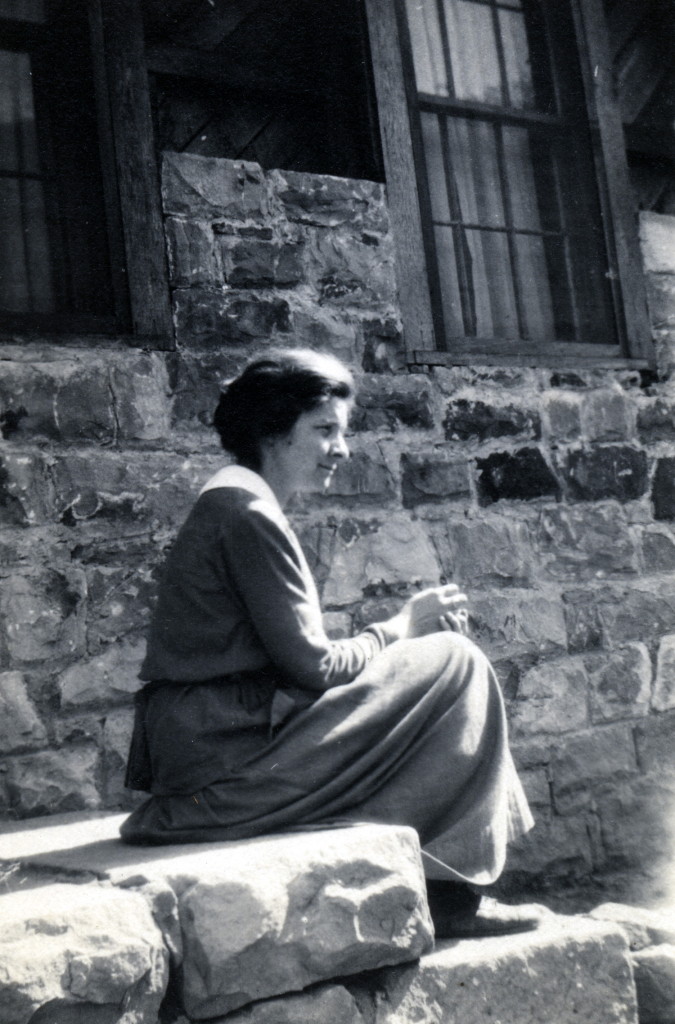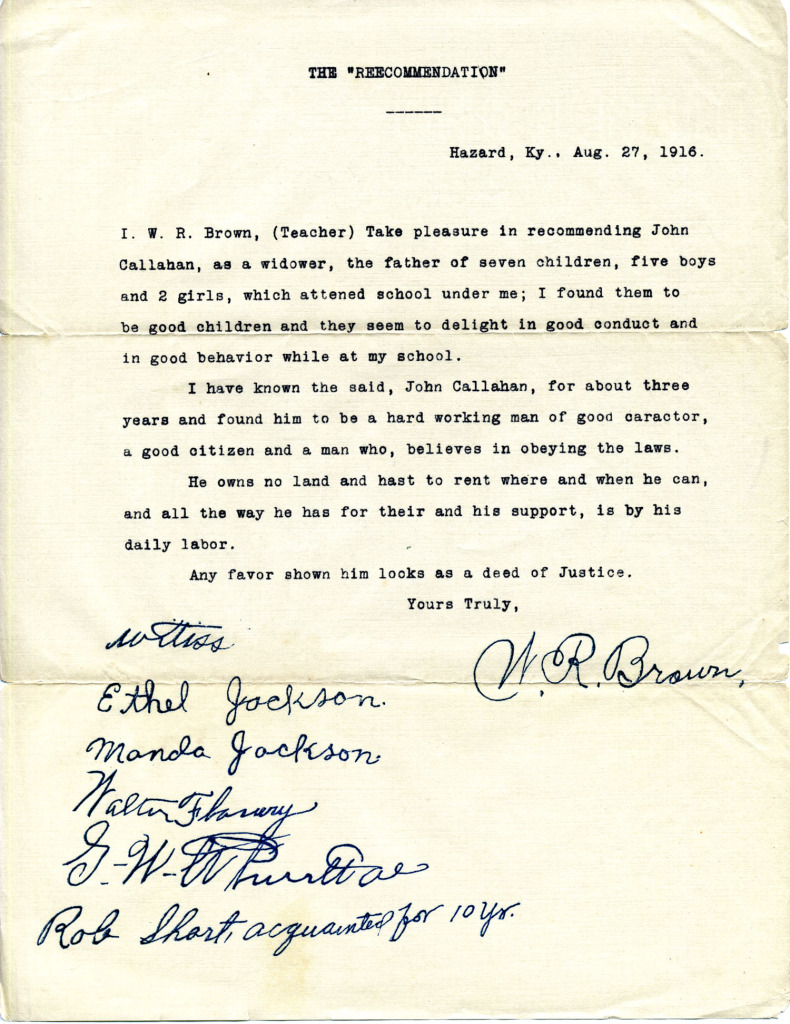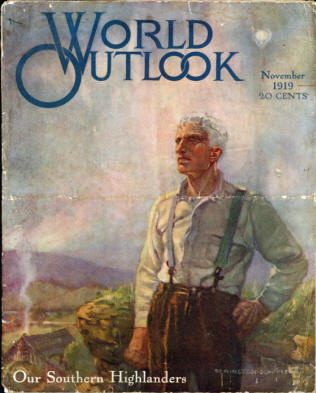Pine Mountain Settlement School
Series 03: GOVERNANCE
Series 04: HISTORIES
Series 09: BIOGRAPHY – Staff
Series 10: BUILT ENVIRONMENT
Wells Record 05 PMSS Support and Budget
Evelyn K. Wells

Evelyn K. Wells seated on the steps of the Office at PMSS. [X_099_workers_2527v_mod.jpg]
WELLS RECORD PMSS 05 Support and Budget, 1913-1928
By Evelyn K. Wells
TAGS: Wells Record PMSS 05 Support and Budget, Evelyn K. Wells, budgets, growth, buildings, administration, Ethel de Long Zande, William Creech Memorial Fund, William Creech, Callahans, subscribers, fund-raising, book-keeping, accounting, audits, financials, 1913-1928, John Callahan, Callahan Letter, Dear Friends Letters, subscriptions, J.S. Duncan, Southern Industrial Education Association
In section 05 of Evelyn K. Wells’ “A Record of Pine Mountain Settlement School,” she traces the development of support and the early institutional budget and the move toward financial sustainability from 1913-1928. This section, titled “Wells’ Record 05 PMSS Support and Budget,” provides a distinct picture of the financial climate of Pine Mountain as it evolved.
WELLS RECORD PMSS 05 Support and Budget
SUPPORT AND BUDGET
The support of Pine Mountain has come from hundreds of sources — individuals, clubs of all sorts, many different church denominations, schools, etc., but never from a special board such as runs a church school The diverse origin of our supporting interest accounts to a great extent for its liveliness, but the raising of money from Pine Mountain has been an arduous task. Our Board of Trustees has never carried the actual financial responsibility, though “never lacking in moral support.”
During the first six years of the School’s life, appeal letters went to our mailing list about twice a year, but after the institution of the Notes in 1919, there was only one appeal letter a year. We have been convinced that good literature, attractively printed, going to our friends infrequently, brought better results than cheaply printed frequent appeals, so the greatest care has always gone into the composition and printing of the Notes and appeal letters. Mrs. Zande’s literature was more than beautifully written; it carried the life and needs of school and countryside to our friends, making fast friends for us.
From the summer of 1913 until her marriage in 1918, Mrs. Zande made trips once or twice a year. She met individuals, groups societies of all sorts, to whom she made the work at the school unforgettably real and appealing. In 1917 Miss Angela Melville unforgettably real and appealing. In 1917 Miss Angela Melville made a three months’ 2 trips for the School, and in 1920 she spent six months raising a fund half of which was for extension work, and half for the Endowment Fund, in Ohio and Kentucky. Miss Lucretia Garfield and Miss Marguerite Butler made short trips. Miss Evelyn Wells made three, in 1921, 1922 and 1924. The policy of all speakers from the School has been to tell the story of our work, letting the facts ask for money, rather than appealing directly for contributions.
Our mailing list has been from the very first made up of people whom we actually knew to be interested. There has always been a direct Pine Mountain contact. We have sedulously culled it of “dead wood”, though we have been wary of removing people except for good reasons as we often found that a friend who had not given for seven, or even ten years, was still interested and considered himself “active.” the list grew from very small beginnings to 5200 in the fall of 1916, when the “Callahan Letter” made so many new friends for us that it had jumped to 5200 the following winter. In 1921 we were sending literature to 6000 people, and then the list grew slowly to 6500, at which we have kept it.
In the beginning, as was natural, many Hindman friends wanted to transfer their interest to the new school, but Pine Mountain always urged them to keep their Hindman connection, adding Pine Mountain if it was possible to their list of benevolences, but never substituting it.
The hope of support was placed at once in the “building up of a group of annual pledge givers. While we have always felt that our Annual Subscribers were our “Rocks of Gibraltar”, they have been mostly small givers, and the many who were just as regular with their gifts, but unwilling to sign pledge cards, have been a great bulwark.”
Personal letters, continuing some bit of school life or picture of conditions in the countryside, have gone to every contributor, thus keeping interest from growing perfunctory.
The Endowment fund was started at the beginning, growing quietly without solicitation, except for the William Creech Memorial Fund. It was Mrs. Zande’s intention to double it by a campaign when it had reached $100,000 as she felt that people would be more interested to help a fund that was already substantially big. The figures below will show how this fund grew, but they cannot show how gratefully and with what relief we invested each gift as it came in, watching our income begin to help in the burden of running expenses. The only direct appeal for Endowment in [ ‘ 43$)i}i^Bj£&ii –of literature was the account sent out after Uncle William died, of his life, his service to his community, and our wish to create a William Creech Memorial Fund. This fund was built up by fairly small gifts, until it reached something over $3500.
From a financial point of view, the most successful piece of literature ever sent out from the school was the “Callahan Letter” in September 1916. We had literally not a penny in the bank, and it was the beginning of a school year, with teachers’ salaries, bills for the year’s supplies, and the heavy expenses that accompanied the construction period of the school. While gifts had provided in the main for our building, there were countless expenses that were inevitable, and not included in the big gifts that were building the first Schoolhouse, or the barn or the farmhouse or other buildings going up at the time. Mr. Callahan‘s visit to Miss de Long and his story of his seven motherless children was not more pathetic or appealing than any that we were continually hearing, and indeed many of our children were in worse plight than the little Callahans; but somehow the essential need of the mountains was in his story, and as it went to our friends, it provoked immediate and generous response. It was reprinted all over the country and people gave and gave. It is hard to describe the joy and amazement of the workers here, as night after night the mail-bag was opened. The first two nights mail totaled $4,000, and it streamed in until at $20,000. we stopped keeping track.
Needless to say, all beyond actual running expense needs for the winter was invested. In view of the fact that America went to war the following spring, and the whole country was deaf for some time to new interests and demands beside the war, it was providential that Pine Mountain could add so substantially to the list of friends before that time by means of the Callahan letter [Re: John Callahan and his 7 children. 1916 letter written by W.R. Brown].

“The ‘Recommendation'” by W.R. Brown, Teacher, recommending the Callahan Family. August 27, 1916. [callahan_children_001]
The gift of an Addressograph by Mr. J.C. Duncan, (sic, J.S. Duncan) in 1926, closed a long period of labor at envelopes directed by hand or typewriter, and meant a tremendous easement in getting out our literature.
As a result of Mrs. Zande’s early trips, several groups organized as Pine Mountain Associations, pooling their interest for some specific need of the school. Some of the smaller ones did not survive, though much of the individual interest has continued, but three of then, Montclair, Plainfield and New Canaan, have given steadily. New Canaan’s annual help goes into our nurse’s salary; Montclair and Plainfield give to our general fund. Plainfield, in addition to their annual pledge of $700.00, sends a Christmas check making a total of a thousand a year; Montclair adds to its annual contribution a Christmas gift of valuable books. The Montclair Association gave the memorial tablet to Mrs. Zande in the Chapel; the building itself is the outcome of Plainfield interest, Miss Jessie Munger, the giver, being a member of that group.
Of course much has been written about Pine Mountain, but the people here have had very little time to put into magazine publicity. In 1917, a year crammed with a heavy building program, Miss de Long however found time to write articles for the Survey and the Outlook, and from time to time she contributed to the Smith Alumnae Quarterly.

“World Outlook,” Cover. November 1919. [world_outlook_cover_mod-1]
Pine Mountain “began in June 1913 with a list of 100 givers, whose contributions totaled $8500, of which $191 was in annual subscriptions, but by the fall of the same year, we had $470 in annual subscriptions, and later $520. That fall an appeal was sent out for a building fund of $10,000.”
Annual subscriptions have varied as follows:
| 1914 | 1915 | 1919 | 1922 | 1925 | 1928 | |
| January | $225 | 347 | 1273 | 1339 | 1280 | 1461 |
| February | 202 | 281 | 1154 | 1374 | 1320 | 1163 |
| March | 83 | 93 | 1140 | 1080 | 1421 | 1353 |
| April | 293 | 280 | 632 | 736 | 1363 | 1066 |
| May | 37 | 140 | 1335 | 1260 | 1421 | 1591 |
| June | 67 | 79 | 527 | 787 | 1394 | 1298 |
| July | 104 | 302 | 534 | 968 | 1469 | 1548 |
| August | 117 | 78 | 1296 | 858 | 1083 | 852 |
| September | 165 | 180 | 1083 | 925 | 892 | 1390 |
| October | 44 | 63 | 1710 | 1951 | 1259 | 834 |
| November | 65 | 239 | 1426 | 1312 | 1239 | 1135 |
| December | 116 | 293 | 803 | 700 | 1017 | 1047 |
Various facts stand out, such as the following: In 1914 our monthly budget was 700. See above figures for what we could count on from annual subscribers In 1924, the annual subscriptions averaged for each month a third of our expenses. In 1916, our monthly budget was $1500, and only one month, October, was sufficiently pledged for. The falling off in some cases is accounted for by the fact that figures were compiled after the list had been culled of inactive subscribers, in some cases by the death or other removal of givers.
While we are not presenting a comparative study of salaries, the salary budget for the first month of the school’s life, May 1913, is interesting:
| Farmer | $75.00 |
| Nurse | 41.67 |
| Secretary | 45.00 |
| Miss de Long [co-founder] | 133.33 |
| Fitzhugh Draughn [Laborer] | 40.00 |
| Berth Lewis [Housekeeping] | 7.00 |
The endowment fund has grown as follows:
| 1916 | $1,513 | 1923 | $35,963 |
| 1917 | 10,110 | 1924 | 44,912 |
| 1918 | 11,272 | 1925 | 49,972 |
| 1919 | 23,872 | 1926 | 56,993 |
| 1920 | 28,972 | 1927 | 71,092 |
| 1922 | 35,043 | 1928 | 77,400 |
The largest gift to this fund was from Mr. J.S. Duncan of Chicago in 1922, $15,000.
Contributions and Subscriptions:
| Contributions & Subscriptions |
Total Expenditures | Total Fixed Assets | |
| 1916 | $45,855 | ||
| 1917 | 33,753 | ||
| 1918 | 60,388 (Inc. Road fund) | ||
| 1919 | 48,109 | ||
| 1920 | |||
| 1921 | 68,228 | ||
| 1922 | 42,207 | $49,848 | $106,859 |
| 1923 | 59,873 | 59,997 | 116,322 |
| 1924 | 45,218 | 50,492 | 173,790 |
| 1925 | 53,593 | 52,594 | 187,448 |
| 1926 | 52,139 | 57,428 | 139,597 |
| 1927 | 31,119 | 53,428 | 145,152 |
| 1928 | 42,889 | 52,715 | 149,000 |
From the annual audits taken from 1922 on, the figures for total expenditures and total fixed assets were picked out as showing the variation in the budget and the growth of value in the school property those figures are of course available for the years previous to 1922, but have not been worked out from the first book-keeping system.
Formal book-keeping began in 1916 with a system instituted by Meldrum and Meldrum of Louisville, and this system was changed in 1922, since when Messrs G.D. Mansell & Son of Cincinnati have kept some of our books and made our audit.
Part of the first book-keeping system was an elaborate student labor record which was discontinued as unnecessarily complicated and not especially significant in making the children realize the value of their work.
See Also:
EVELYN K. WELLS GUIDE TO Administrative Correspondence
EVELYN K. WELLS, GUIDE to EXCERPTS FROM LETTERS HOME 1915-1923
EVELYN K. WELLS 1915 EXCERPTS FROM LETTERS HOME
EVELYN K. WELLS 1915 EXCERPTS FROM LETTERS HOME – Horseback to Hindman
EVELYN K. WELLS 1916 EXCERPTS FROM LETTERS HOME
EVELYN K. WELLS 1917 EXCERPTS FROM LETTERS HOME
EVELYN K. WELLS 1918 EXCERPTS FROM LETTERS HOME
EVELYN K. WELLS 1919 EXCERPTS FROM LETTERS HOME
RECORD OF PINE MOUNTAIN SETTLEMENT SCHOOL 1913-1928 [INDEX] (Early in-depth history of Pine Mountain Settlement School)
2. Introductory
3. Year by Year [Construction, Workers, Gifts, Children, Events, etc.]
10. Academic
11. Health
12. Extension Work
15. Athletics
16. Dramatics
17. Some Contributions to the Outside World
18. Religious Life
19. The Road
22. List of Workers
[22 sections of Pine Mountain Settlement School History gathered by Evelyn K. Wells from 1913 to 1928]
EVELYN K. WELLS PUBLICATIONS
Wells, Evelyn K. The Ballad Tree: A Study of British and American Ballads, Their Folklore, Verse and Music, Together with Sixty Traditional Ballads and Their Tunes. New York: Ronald Press, 1950. Print.
EVELYN K. WELLS “A Little True Blue American,” Over Sea and Land: Our Southern Mountains, November 1920, p. 140.
EVELYN K. WELLS TALKS
EVELYN K. WELLS PMSS Harvard University talk, on Folk Music. July 21, 1955

